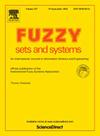Interval type-2 fuzzy H∞ filtering for nonlinear singularly perturbed jumping systems: A semi-Markov kernel method
IF 3.2
1区 数学
Q2 COMPUTER SCIENCE, THEORY & METHODS
引用次数: 0
Abstract
This paper addresses the filtering issue for nonlinear singularly perturbed jump systems with semi-Markov process. The interval type-2 fuzzy model is employed to handle the uncertain features and nonlinearity inherent in the considered systems. Designing an interval type-2 fuzzy filter, it is related to the system mode but remains independent of the singular perturbation parameter, this approach utilizes the semi-Markov kernel method and non-parallel distributed compensation technique. Some criteria with incorporating the message of membership functions are derived to ensure that the filtering error system is mean-square exponentially stable while meeting specified performance. Introduction of slack matrices with two adjustable scalars facilitates obtaining the interval type-2 fuzzy filter gains. The rationality of the proposed approach is demonstrated through the utilization of two examples, including a circuit model.
求助全文
约1分钟内获得全文
求助全文
来源期刊

Fuzzy Sets and Systems
数学-计算机:理论方法
CiteScore
6.50
自引率
17.90%
发文量
321
审稿时长
6.1 months
期刊介绍:
Since its launching in 1978, the journal Fuzzy Sets and Systems has been devoted to the international advancement of the theory and application of fuzzy sets and systems. The theory of fuzzy sets now encompasses a well organized corpus of basic notions including (and not restricted to) aggregation operations, a generalized theory of relations, specific measures of information content, a calculus of fuzzy numbers. Fuzzy sets are also the cornerstone of a non-additive uncertainty theory, namely possibility theory, and of a versatile tool for both linguistic and numerical modeling: fuzzy rule-based systems. Numerous works now combine fuzzy concepts with other scientific disciplines as well as modern technologies.
In mathematics fuzzy sets have triggered new research topics in connection with category theory, topology, algebra, analysis. Fuzzy sets are also part of a recent trend in the study of generalized measures and integrals, and are combined with statistical methods. Furthermore, fuzzy sets have strong logical underpinnings in the tradition of many-valued logics.
 求助内容:
求助内容: 应助结果提醒方式:
应助结果提醒方式:


